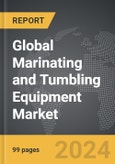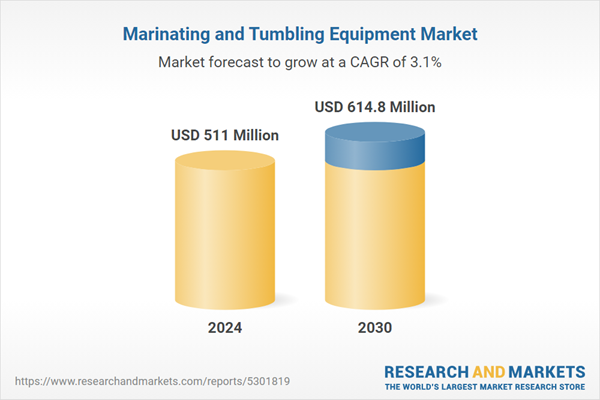Global Marinating and Tumbling Equipment Market - Key Trends and Drivers Summarized
What Are Marinating and Tumbling Equipment, and How Do They Function?
Marinating and tumbling equipment are vital components in the modern food processing landscape, particularly in industries focused on meat, poultry, seafood, and even plant-based protein production. These machines are engineered to enhance the flavor, texture, and overall quality of food by infusing marinades, seasonings, and other additives directly into the food product. Tumbling equipment typically operates by rotating the food products in a drum, which helps to evenly distribute the marinade and break down the fibers, making the food more tender and flavorful. In vacuum tumblers, the removal of air allows the marinade to penetrate deeper into the product, reducing the time required for marination and ensuring uniform flavor throughout the product. Marinating equipment, on the other hand, is specifically designed to disperse liquid marinades and seasonings uniformly across a variety of food products. These machines are incredibly versatile, processing everything from sausages and steaks to seafood fillets and plant-based meat alternatives, offering a solution that minimizes manual labor, accelerates production, and ensures consistency in product quality. Their adoption has become increasingly widespread due to their ability to handle large-scale production demands while maintaining the integrity of the food.How Do Innovations in Marinating and Tumbling Technology Shape Food Production?
Recent innovations in marinating and tumbling technology have significantly impacted food production processes, introducing a new level of efficiency, precision, and scalability. One of the most notable trends is the increased integration of automation within these systems. Modern marinating and tumbling machines are equipped with programmable logic controllers (PLCs) that allow operators to customize the rotation speed, vacuum levels, marination cycle times, and other parameters according to the specific needs of the food being processed. This level of precision ensures that the products maintain optimal texture and flavor, reducing the risk of over or under-marination. Real-time monitoring systems have also been incorporated, providing operators with constant feedback on the status of the marinating process, which guarantees consistent product results and reduces waste. Additionally, advancements in drum design, such as non-stick coatings and dual-action rotating mechanisms, improve the efficiency of the tumbling process by preventing the product from sticking to the drum and maximizing the surface area exposed to the marinade. These developments not only boost production speeds but also result in reduced ingredient waste and improved overall product yield, making these technologies a cost-effective investment for food manufacturers seeking to optimize their operations and ensure consistent product quality.Why Are These Machines Essential for the Growing Demand for Convenience Foods?
As consumer lifestyles continue to shift toward faster, more convenient meal solutions, the demand for marinated, ready-to-eat (RTE) and convenience foods has surged. Marinating and tumbling equipment have become indispensable tools for food manufacturers looking to meet this growing demand, as they allow producers to deliver flavorful, tender, and fully seasoned products at scale. The ability of these machines to shorten marination times without sacrificing flavor or texture is crucial in industries where speed and efficiency are essential to staying competitive. In the production of frozen meals, pre-seasoned meats, and seafood products, the consistency provided by these machines ensures that consumers experience the same quality in every batch, which is critical for brand loyalty. Moreover, the versatility of marinating and tumbling equipment makes them suitable for processing plant-based protein alternatives, a rapidly growing segment of the market. As more consumers seek vegetarian and vegan options that offer the same savory experience as meat-based products, these machines play a pivotal role in developing and producing plant-based products with enhanced flavor profiles. The equipment's role in producing uniformly marinated, ready-to-cook or ready-to-eat foods makes it an essential asset for food manufacturers striving to meet the increasing consumer demand for convenience without compromising on quality or taste.What Is Driving the Growth in the Marinating and Tumbling Equipment Market?
The growth in the marinating and tumbling equipment market is driven by several factors, including technological advancements, evolving consumer preferences, and increasing regulatory emphasis on food safety. Automation remains a significant growth driver as it reduces labor costs, enhances production efficiency, and ensures product uniformity on a large scale. The ability to automate complex processes, such as adjusting marination cycles and vacuum levels, allows manufacturers to increase their output without sacrificing quality, meeting the growing demand for processed and convenience foods. In parallel, shifting consumer preferences toward ready-to-eat meals, frozen foods, and plant-based protein alternatives are also fueling market growth. As consumers lead busier lives and seek quick, flavorful meal solutions, the demand for products that are both convenient and high in quality has escalated, driving the need for advanced marinating and tumbling solutions that can meet these expectations. Moreover, the trend toward clean-label, minimally processed foods has influenced equipment development, as consumers prefer products that offer natural flavors and textures without excessive additives. Food safety has also emerged as a critical market driver. Stricter hygiene and safety regulations in the processing of meat, poultry, and seafood have increased the adoption of sophisticated marinating and tumbling systems, which are designed to minimize the risk of contamination. The inclusion of real-time monitoring and data analytics in these machines further enhances control over the production process, contributing to the overall growth of the market.Report Scope
The report analyzes the Marinating and Tumbling Equipment market, presented in terms of market value (US$ Thousand). The analysis covers the key segments and geographic regions outlined below.- Segments: Segment (Marinating & Tumbling Equipment).
- Geographic Regions/Countries:World; United States; Canada; Japan; China; Europe (France; Germany; Italy; United Kingdom; Spain; Russia; and Rest of Europe); Asia-Pacific (Australia; India; South Korea; and Rest of Asia-Pacific); Latin America (Argentina; Brazil; Mexico; and Rest of Latin America); Middle East (Iran; Israel; Saudi Arabia; United Arab Emirates; and Rest of Middle East); and Africa.
Regional Analysis
Gain insights into the U.S. market, valued at $137.6 Million in 2024, and China, forecasted to grow at an impressive 5.3% CAGR to reach $121.9 Million by 2030. Discover growth trends in other key regions, including Japan, Canada, Germany, and the Asia-Pacific.Why You Should Buy This Report:
- Detailed Market Analysis: Access a thorough analysis of the Global Marinating and Tumbling Equipment Market, covering all major geographic regions and market segments.
- Competitive Insights: Get an overview of the competitive landscape, including the market presence of major players across different geographies.
- Future Trends and Drivers: Understand the key trends and drivers shaping the future of the Global Marinating and Tumbling Equipment Market.
- Actionable Insights: Benefit from actionable insights that can help you identify new revenue opportunities and make strategic business decisions.
Key Questions Answered:
- How is the Global Marinating and Tumbling Equipment Market expected to evolve by 2030?
- What are the main drivers and restraints affecting the market?
- Which market segments will grow the most over the forecast period?
- How will market shares for different regions and segments change by 2030?
- Who are the leading players in the market, and what are their prospects?
Report Features:
- Comprehensive Market Data: Independent analysis of annual sales and market forecasts in US$ Million from 2024 to 2030.
- In-Depth Regional Analysis: Detailed insights into key markets, including the U.S., China, Japan, Canada, Europe, Asia-Pacific, Latin America, Middle East, and Africa.
- Company Profiles: Coverage of players such as Baader Food Processing Machinery, Inc., Bayle S.A., Brower Equipment, CG Manufacturing And Distribution Limited, CTB Inc. and more.
- Complimentary Updates: Receive free report updates for one year to keep you informed of the latest market developments.
Some of the 54 companies featured in this Marinating and Tumbling Equipment market report include:
- Baader Food Processing Machinery, Inc.
- Bayle S.A.
- Brower Equipment
- CG Manufacturing And Distribution Limited
- CTB Inc.
- John Bean Technologies Corporation
- Key Technology, Inc.
- Marel HF
- Prime Equipment Group, Inc.
This edition integrates the latest global trade and economic shifts into comprehensive market analysis. Key updates include:
- Tariff and Trade Impact: Insights into global tariff negotiations across 180+ countries, with analysis of supply chain turbulence, sourcing disruptions, and geographic realignment. Special focus on 2025 as a pivotal year for trade tensions, including updated perspectives on the Trump-era tariffs.
- Adjusted Forecasts and Analytics: Revised global and regional market forecasts through 2030, incorporating tariff effects, economic uncertainty, and structural changes in globalization. Includes historical analysis from 2015 to 2023.
- Strategic Market Dynamics: Evaluation of revised market prospects, regional outlooks, and key economic indicators such as population and urbanization trends.
- Innovation & Technology Trends: Latest developments in product and process innovation, emerging technologies, and key industry drivers shaping the competitive landscape.
- Competitive Intelligence: Updated global market share estimates for 2025, competitive positioning of major players (Strong/Active/Niche/Trivial), and refined focus on leading global brands and core players.
- Expert Insight & Commentary: Strategic analysis from economists, trade experts, and domain specialists to contextualize market shifts and identify emerging opportunities.
Table of Contents
Companies Mentioned (Partial List)
A selection of companies mentioned in this report includes, but is not limited to:
- Baader Food Processing Machinery, Inc.
- Bayle S.A.
- Brower Equipment
- CG Manufacturing And Distribution Limited
- CTB Inc.
- John Bean Technologies Corporation
- Key Technology, Inc.
- Marel HF
- Prime Equipment Group, Inc.
Table Information
| Report Attribute | Details |
|---|---|
| No. of Pages | 150 |
| Published | January 2026 |
| Forecast Period | 2024 - 2030 |
| Estimated Market Value ( USD | $ 511 Million |
| Forecasted Market Value ( USD | $ 614.8 Million |
| Compound Annual Growth Rate | 3.1% |
| Regions Covered | Global |









